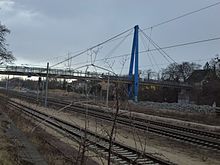Wolfen bush
The Wolfener Busch is an alluvial forest on the eastern edge of Wolfen and is a particularly protected biotope .
location
The forest extends over an area of 20 hectares and is bounded in the west by the Dessau-Leipzig railway line and in the east by the premises of a sewage treatment plant, behind which the Salegaster Forest begins . On the northern edge there is an allotment garden and a tennis court, in the south an industrial park.
Originally the Wolfener Busch belonged to a large alluvial forest that stretched along the Mulde . Despite its small area and the spatial separation from the Mulde, the Wolfener Busch is rated as ecologically valuable.
flora
The Wolfener Busch has a multi-layered vegetation (herb layer, shrub layer and tree layer) typical of alluvial forests.
In the near-Earth herbaceous layer in Wolfener Busch following species occur: wood anemone , spring celandine , dog violets , March Violets , Viola hirta and Solomon's seal . In the area of the edge of the forest or in clear places you can find: blue adder's head , burdock bedstraw , Ruprechts cranesbill , silver cinquefoil and white catchwort .
The shrub layer is mainly characterized by barberry , common hawthorn , common privet , purge buckthorn , red honeysuckle , snowberry and black elder .
The tree layer is characterized by common ash , hornbeam and English oak . However, there are also sycamore maple , silver birch , robinia , black poplar , summer linden , bird cherry and Scots pine .
The different layers are connected, among other things, by the common ivy and the common hops , which are common representatives of the European lianas .
fauna
Mammals
Deer and squirrels can be observed in mammals , but the occurrence of the wood shrew has also been proven. In addition, there are bats, especially the Bechstein's bat . To protect the bats, sleeping boxes and bat caves were set up in the Wolfener Busch.
Birds
The Wolfener Busch also serves as a habitat for a large number of bird species. There were observed: blackbird , wagtail , blue tit , chaffinch , great spotted woodpecker , jay , magpie , Siskins , treecreeper , Bullfinch , Green Finch , Green Woodpecker , Stock Dove , grosbeak , nuthatch , great tit , raven , blackcap , Nightingale , hooded crow , Nordic Brambling , wood pigeon , robin , Red Kite , Rook , long-tailed tit , black woodpecker , thrush , Star , Stieglitz , tawny owl , wood warbler , willow tit , white-backed woodpecker , wren and Zilpzalp .
However, not all bird species breed in the Wolfen bush. Many can only be found temporarily or at certain times of the year. In 1986 the white-backed woodpecker, which is rather unusual in the region, was observed in the Wolfener Bush.
Amphibians and reptiles
The sand lizard occurs at the edge of the forest . Between 1992 and 1994, populations of common toad , pond newt and green toad had formed in the abandoned pools of a swimming pool once located on the southern edge of the Wolfener Busch . After the basin was backfilled, the common toad population in particular persisted for a while in a shallow water basin created as compensation. However, this spawning water has now also silted up.
insects
Among the insects, the occurrence of the blue-winged wasteland insect is particularly noteworthy.
literature
- Detlef Eisewicht: The Wolfener Busch . Information brochure, publisher: Arbeitskreis Hallesche Auenwälder zu Halle (Saale) eV
Coordinates: 51 ° 39 ′ 49 ″ N , 12 ° 16 ′ 57.4 ″ E
